Automated Guided Vehicles (AGVs) are transforming industries by streamlining material handling processes, improving safety, and enhancing operational efficiency. These robotic vehicles navigate autonomously within facilities, relying on technologies like sensors, cameras, and laser-guided systems to follow predetermined paths or dynamically adapt to their surroundings. AGVs are commonly used in warehouses, manufacturing plants, and distribution centers to transport goods, raw materials, and finished products.
https://www.yunwu-agv.cc/automated-guided-vehicle/
One of the primary advantages of AGVs is their ability to reduce labor costs and human error while increasing throughput. By automating repetitive tasks, such as moving inventory or transporting goods between stations, AGVs free up human workers to focus on more complex and value-added tasks. This not only improves productivity but also enhances workplace safety, as AGVs can operate in environments that may be hazardous for humans, such as areas with heavy machinery or dangerous chemicals.
AGVs come in various types, including tow vehicles, unit load carriers, and forked vehicles, each designed for specific tasks. These vehicles can be integrated with advanced warehouse management systems (WMS) and enterprise resource planning (ERP) software, enabling real-time tracking, inventory management, and predictive maintenance. As technology evolves, AGVs are becoming more versatile, with the integration of artificial intelligence (AI) and machine learning capabilities, allowing them to optimize routes and adapt to dynamic environments.
In the future, AGVs are expected to play an even larger role in the supply chain, contributing to the development of smart factories and autonomous logistics networks. Their ability to increase efficiency, reduce operational costs, and improve safety positions them as a key technology for industries aiming to stay competitive in the rapidly evolving market.






Top comments (0)